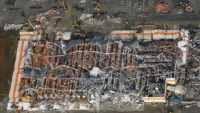ASCE Post-Tornado Report Finds Connection Between Load Paths, Building Survivability
Even the most well-constructed building may have little chance against a direct hit from the 200-mph winds of an EF5 tornado. But a recently released ASCE study suggests that, away from the center of these catastrophic twisters, building performance may improve with greater attention to structural load paths and construction quality while also helping structures to withstand direct hits from smaller, less powerful storms.
The study, sponsored by ASCE’s Structural Engineering Institute, examined damage at various locations in Moore, Okla., following a deadly EF5 tornado that hit the Oklahoma City suburb on May 20, 2013. By documenting critical-failure mechanisms in the damaged structural systems, the team of structural engineers and high-wind building-design specialists sought to determine the cause of the failures.
Moore made for an interesting case, given the region’s history of severe tornadoes, including an EF5 twister that struck Moore in 1999, explains William Coulbourne, the Delaware-based consulting structural engineer who led the study.
“We wanted to see if anything had been improved upon since then,” says Coulbourne, adding that reports of damage to schools and a medical center “gave us the opportunity to look at different types of construction.”
The study team discovered numerous examples of faulty construction and non-compliance with codes for steel and reinforced-masonry buildings, particularly at two heavily damaged schools built before the International Building Codes (IBC) were developed in 2000. One of the most common deficiencies was inconsistent load-path continuity, including substandard roof-to-foundation connections.
“Where we saw failures with connections, we saw the load path compromised,” Coulbourne says, adding that Moore followed the pattern of other post-disaster inspections that typically reveal evidence of non-compliant construction.
“There could be many reasons, from lax inspection to a builder not knowing what to do,” he notes.
Such deficiencies are particularly worrisome because, when major storms threaten an area, schools and other critical buildings are often assumed to be safe havens, Coulbourne says. In Moore, approximately 200 citizens took shelter inside a medical center, which, nevertheless, sustained extensive building-envelope damage when the tornado struck with winds estimated at 188 mph. No part of the then-eight-year-old building had been designed or built according to published standards for storm shelters.
“They survived with no injuries, but they were very, very fortunate,” Coulbourne says.
The investigators note that because the schools were in the direct path of such a powerful tornado, the catastrophic damage might have been unavoidable. On the other hand, code-compliant construction, including continuous load paths, might stand up better to less violent storms, potentially resulting in better performance even when the twister exceeds the building’s designed wind load.
The 2015 edition of the IBC sets a wind-speed design minimum for tornadoes at 115 mph and calls for most schools to have storm shelters capable of surviving 250 mph winds. Two of Moore’s damaged schools have been rebuilt to that standard, while a recently passed bond issue is funding safe-room retrofits for other schools in the city.
Still, Coulbourne says tornadoes are not understood well enough for these measures to be completely fail-safe.
“There is a lot about tornadoes that we don’t know, such as wind speeds and uplift pressure when a storm passes over a building,” he says. “We can’t assume that something built to withstand a hurricane will perform equally well in a tornado.”
The ASCE study team recommends communities in tornado-prone areas be more proactive in assessing vulnerabilities and ensuring building-code compliance. Design teams also can play a role, says Coulbourne.
“With what we know about tornadoes, the structural engineer or architect should have a conversation with the owner on how he wants the building to perform,” he says. “There are a lot of ways to deal with the issue.”





